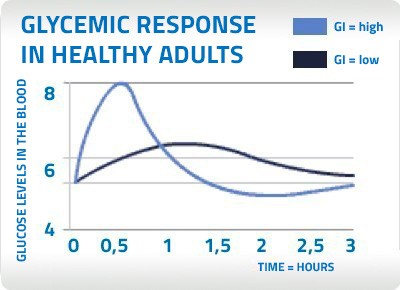The importance of a low glycemic index
WHAT’S THE GLYCEMIC INDEX AND WHY IS IT IMPORTANT TO KEEP IT LOW DURING SOME PHYSIOLOGIC/PATHOLOGIC STATES?
The nutrition for a dog or a cat should be almost without carbohydrates as their metabolism evolved to gain Energy from animal proteins and fats. Carbohydrates provide our pets unwanted calories, nevertheless most of the industrial foods on the market contain from 40% to 60% of them.
Carbohydrates in cereals traditionally used in dog and cat food formulas provide a high energy quantity as glucose that induces a quick postprandial glycemic peak. Especially in these cases, postprandial insulin response to glucose and its modulation ability on different types of carbohydrates is crucial.

The effects of a carbohydrates source on glycemic level is provided by the Glycemic Index. Foods with a low Glycemic Index are better assimilated, as their absorption time is modulated, hence there is a reduction of physical stress and consequent efficiency raise.
A high Glycemic Index, linked to cereals rich in starch highly digestible, predisposes to pathologies such as obesity and diabetes, both in human and animal.
There are phisiological and pathological conditions where a low sugar level is crucial and that's why we developed some low glycemic index formulas: Obesity, Neutered, Diabetic, Joint. In these formulas low glycemic index is functional to a moderate postprandial glycemic response better modulated over time.

